Mechanical Properties and Influencing Factors of Shield Cutting Existing Station Supporting Piles
Abstract
:1. Introduction
2. General Engineering Situations
2.1. Project Information
2.2. Geological Situation
2.3. Arrangement of Shield Cutters
3. Numerical Model of Cutting Concrete
3.1. Parameters of Concrete Constitutive Model
3.1.1. Yield Surface Strength Model
3.1.2. Equation of State
3.1.3. Damage Model
3.2. 3D Model of Cutter Cutting Concrete
4. Failure Mechanism and Mechanical Properties of Cutting Concrete
4.1. Failure Mechanism of Cutting Concrete
4.2. Cutting Force Characteristics
- (1)
- The whole cutting process always maintains cutting force > penetration force > tangential force. For the positive rake angle cutter tool, the cutting force is significantly greater than the penetration force, with a good correlation.
- (2)
- Because the cutter is regular and symmetrical in the direction of cutter width, the tangential force changes slightly near zero. Under the current cutting conditions, due to the symmetry of the tool structure on both sides, the lateral forces generated on both sides offset each other.
- (3)
- In the initial stage of the process of a cutter contacting concrete, the contact force increases rapidly with the increase in the contact area of the cutter. After reaching the maximum value, it begins to enter the steady-cutting state. Due to the uncertainty of the contact position and the deletion element, the force is discontinuous, and the cutting force fluctuates around the average value. Therefore, the shield cutter is easily damaged by large impacts during the initial cutting process.
4.3. Cutting Stress Characteristics
- (1)
- During the cutting process, the equivalent stress of concrete is maintained at 160 MPa, and the maximum value is 219 MPa, which is much larger than the compressive strength of concrete.
- (2)
- During the cutting process, the maximum stress occurs at the contact area between the tool and concrete and gradually decreases outward. As the saw blade cuts deeper into the concrete, the maximum stress area of the concrete shifts along the cutting direction of the blade.
- (3)
- Residual stress and strain still exist in the cutting tool passing area. It is because plastic deformation occurs in concrete during cutting. The plastic deformation of the tool after unloading partially limits the recovery of deformation in the adjacent area, resulting in residual stress.
4.4. Analysis of the Influence of Different Factors on Cutting
4.4.1. Cutting Speed
4.4.2. Cutting Depth
4.4.3. Cutter Width
4.4.4. Angle of Cutting Edge
4.5. Model Verification
4.5.1. The I.Evans Model
4.5.2. Theoretical Model of Japanese Scholars
5. Significance Analysis of Cutting Influencing Factors
5.1. Orthogonal Test Range Analysis
5.2. Orthogonal Test Variance Analysis
5.3. Shield Machine Construction and Tool Parameter Optimization
- (1)
- The shield machine is equipped with a low-speed propulsion function to provide low-speed, stable thrust. The cutting depth as a construction parameter requires the shield machine to adjust the cutting speed and cutter speed control during the operation. The actual propulsion process speed was increased from 3 mm/min to 5 mm/min.
- (2)
- As a measure before pile cutting, the increase in cutter width will increase the force area of the cutter and further increase the cutting force. At the same time, it can reduce the number of cutter installations and reduce the design cost. The actual cutter width is increased from 100 mm to 150 mm.
- (3)
- When cutting the pile foundation, properly increasing the rake angle from 10° to 15° and slightly reducing the cutting force can ensure a reduction in tool wear. This is more suitable for long-term tunneling.
- (4)
- The innovative design of the cutter head has six teeth, and the upper and lower rows are arranged with three teeth each, which can further reduce tool wear and improve the fluidity of soil.
6. Recommendations and Limitations
- (1)
- In the initial stage of concrete cutting, the tool is easily damaged by large impacts, and this process should be carried out at low speed to provide stable thrust and avoid excessive wear of the cutterhead.
- (2)
- In the construction process, the height difference of the tool should be reasonably controlled to avoid the excessive force of the single tool, which leads to the shutdown of the cutterhead.
- (3)
- Before cutting the pile foundation, the cutter width should be adjusted appropriately according to the actual situation of the site to reduce the loss of the shield cutterhead. Appropriately increase the rake angle to reduce the wear of the cutterhead.
7. Conclusions
- (1)
- Cutting concrete can be divided into three stages: the initial cutting stage, the mid-cutting stage, and the final cutting stage. In the initial cutting stage, the concrete exceeds its compressive strength and is crushed under the extrusion of the cutter head. In the mid-cutting stage, the cutter tool continuously squeezes the concrete and continuously cuts the concrete on the path. In the final cutting stage, the whole stripped concrete forms a leap forward in crushing. The tool force drops sharply to 0, and the cutting process is completed. The cutting mechanism of the cutter tool is that the front-end concrete is crushed under pressure to produce a dense core. The stress is transmitted to the surrounding concrete, resulting in the tensile failure of the surrounding concrete unit and the leap-forward crushing.
- (2)
- The cutting force increases rapidly in a short time during the cutting process and begins to enter the steady cutting state after reaching its maximum value. When the cutting is complete, the cutting force drops sharply to 0. The whole cutting process always maintains cutting force > penetration force > tangential force, and the tangential force is basically 0.
- (3)
- Regardless of the cutting temperature, the contact force of the cutter is less affected by the cutting speed. The cutter contact force is linearly proportional to the cutting depth and cutter width, and the fluctuation range also increases. The cutter contact force is linearly and inversely proportional to the rake angle.
- (4)
- Through range analysis and variance analysis, the significance order of the three main influencing factors was obtained: cutting depth > cutter width > rake angle. It is suggested that the cutting depth be adjusted preferentially within the scope of reasonable construction, followed by the cutter width, and finally the rake angle.
Author Contributions
Funding
Institutional Review Board Statement
Informed Consent Statement
Data Availability Statement
Conflicts of Interest
References
- Lu, Z.L.; Wang, X.C.; Teng, H.W.; Guan, X.; Song, C.; Fan, G. Rock-Breaking Laws of Disc Cutters with Different Height Differences in Hard Rock Strata. Adv. Civ. Eng. 2022, 2022, 2282830. [Google Scholar] [CrossRef]
- Wan, C.D.; Jin, Z.Y. Adaptability of the Cutter-Head of the Earth Pressure Balance (EPB) Shield Machine in Water-Rich Sandy and Cobble Strata: A Case Study. Adv. Civ. Eng. 2020, 2020, 8847982. [Google Scholar] [CrossRef]
- Wang, Y.Q.; Wang, X.Y.; Xiong, Y.Y.; Yang, Z.; Zhang, J. Full-Scale Laboratory Test of Cutting Large-Diameter Piles Directly by Shield Cutterhead. Adv. Civ. Eng. 2022, 2022, 8780927. [Google Scholar] [CrossRef]
- Chen, H.F.; Yuan, D.J.; Wang, F.; Wang, M. Study on shield cutting parameters when cutting big diameter piles. China Civ. Eng. J. 2016, 49, 103–109. [Google Scholar]
- Wang, X.Y.; Yuan, D.J. Research on the Interaction between the Pile and Shield Machine in the Process of Cutting a Reinforced Concrete Pile Foundation. Appl. Sci. 2022, 13, 245. [Google Scholar] [CrossRef]
- Deng, L.C.; Yuan, Y.X.; Zhuang, Q.W.; Li, X.Z.; Zhang, C.; Li, W.Y. Novel PDC cutter for reinforced concrete based on linear and rotational cutting tests. Tunn. Undergr. Space Technol. Inc. Trenchless Technol. Res. 2022, 129, 104681. [Google Scholar] [CrossRef]
- Du, C.D.; Zhang, J.; Tang, Z.X. Key Technologies of Shield Direct Cutting Pile Foundation. Tunn. Constr. 2019, 39, 1666–1677. [Google Scholar]
- Wang, Y.L.; Li, J.C.; Liao, S.M. Numerical simulation and measured data analysis of pile group cutting by shield: A case study of running tunnel on line No.9 of Shenzhen Metro. Tunn. Constr. 2017, 37, 192–199. [Google Scholar]
- Wang, W.J.; Yang, W.H.; Liu, M.; Liu, W. Adaptability of remanufactured shield boring underneath piles of a viaduct. Tunn. Constr. 2021, 41, 666–673. [Google Scholar]
- Yu, H.; Chen, L.; Peng, K.X. Adaptability of a Reinforced Concrete Diaphragm Wall Cut by Disc Cutter. Sustainability 2022, 14, 16154. [Google Scholar] [CrossRef]
- Niu, Y.L.; Ren, T.L.; Zhou, Q.; Jiao, X.; Shi, J.; Xiang, K.; Tao, J.; Zhai, Q.; Satyanaga, A. Analysis of Excavation Parameters on Face Stability in Small Curvature Shield Tunnels. Sustainability 2023, 15, 6797. [Google Scholar] [CrossRef]
- Wang, Z.; Wu, S.W.; Yao, W.J.; Zhang, K.W.; Li, Q.; Xu, S.F. Grinding pile technology of shield tunnels crosssing pile foundation of existing bridges. Chin. J. Geotech. Eng. 2020, 42, 117–125. [Google Scholar]
- Wang, G.; Qiao, S.; Li, G.; Singh, J. Direct shield cutting of large-diameter reinforced concrete group piles: Case study on Shenyang Metro construction. Case Stud. Constr. Mater. 2023, 18, e01864. [Google Scholar] [CrossRef]
- Li, X.G.; Yuan, D.J.; Jiang, X.Q.; Wang, F. Damages and wear of tungsten carbide-tipped rippers of tunneling machines used to cutting large diameter reinforced concrete piles. Eng. Fail. Anal. 2021, 127, 105533. [Google Scholar] [CrossRef]
- Yuan, D.J.; Wang, F.; Dong, C.W.; Han, B.; Wang, M. Study on new-style cutter for shield cutting large-diameter reinforced concrete pile. China J. Highw. Transp. 2016, 29, 89–97. [Google Scholar]
- Su, W.L.; Li, X.G.; Xu, Y.; Jin, D.L. Numerical simulation of shield tool cutting concrete based on HJC model. J. Zhejiang Univ. Eng. Sci. 2020, 54, 1106–1114. [Google Scholar]
- Jin, D.L.; Zhang, Z.Y.; Yuan, D.J. Effect of dynamic cutterhead on face stability in EPB shield tunneling. Tunn. Undergr. Space Technol. Inc. Trenchless Technol. Res. 2021, 110, 103827. [Google Scholar] [CrossRef]
- Liu, B.; Li, T.; Han, Y.H.; Li, D.; He, L.; Fu, C.; Zhang, G. DEM-continuum mechanics coupling simulation of cutting reinforced concrete pile by shield machine. Comput. Geotech. 2022, 152, 105036. [Google Scholar] [CrossRef]
- Holmquist, T.J.; Johnson, G.R.; Cook, W.H. A computational constitutive model for concrete subjected to large strains, high strain rates and high pressures. In Proceedings of the International Symposium on Ballistics, Québec City, QC, Canada, 26–29 September 1993; pp. 591–600. [Google Scholar]
- Zhang, L.M.; Zhang, D.; Wang, Z.Q.; Cong, Y.; Wang, X.S. Constructing a three-dimensional creep model for rocks and soils based on memory-dependent derivatives: A theoretical and experimental study. Comput. Geotech. 2023, 159, 105366. [Google Scholar] [CrossRef]
- Wang, H.; Dong, J.; Gu, Z.Z.; Ma, C.X. Numerical Study on the effect of HJC model parameters on penetration. J. Ordnance Equip. Eng. 2020, 41, 200–204. [Google Scholar]
- Zhang, L.M.; Cong, Y.; Meng, F.Z.; Wang, Z.Q.; Zhang, P.; Gao, S. Energy evolution analysis and failure criteria for rock under different stress paths. Acta Geotech. 2021, 16, 569–580. [Google Scholar] [CrossRef]
- Zhang, L.M.; Chao, W.W.; Liu, Z.Y.; Cong, Y.; Wang, Z.Q. Crack propagation characteristics during progressive failure of circular tunnels and the early warning thereof based on multi-sensor data fusion. Geomech. Geophys. Geo-Energy Geo-Resour. 2022, 8, 172. [Google Scholar] [CrossRef]
- Wang, F. Study on Shield Cutting Large Diameter Reinforced Concrete Piles Directly. Ph.D. Thesis, Beijing Jiaotong University, Beijing, China, 2014. [Google Scholar]
- Xu, Y.; Li, X.G.; Yang, Y.; Mu, J.W.; Su, W.L. Dynamic response mechanism of shield cutter in concrete cutting. J. Harbin Inst. Technol. 2021, 53, 182–189. [Google Scholar]
- Ji, Z.Y. Study and Experimental Verification of Cutting Force Model of Soft Rock and Soil by Shield Machine Cutter. Master’s Thesis, Central South University, Changsha, China, 2009. [Google Scholar]
- Zhao, D. Study on the Cutters’ Layout Scheme of Combined Shield Cutterhead. Master’s Thesis, Tianjin University, Tianjin, China, 2012. [Google Scholar]
- Yang, Z.B. Study on Numerical Simulation and Layout of Composite Shield Machine Cutters. Master’s Thesis, Taiyuan University of Science and Technology, Taiyuan, China, 2019. [Google Scholar]

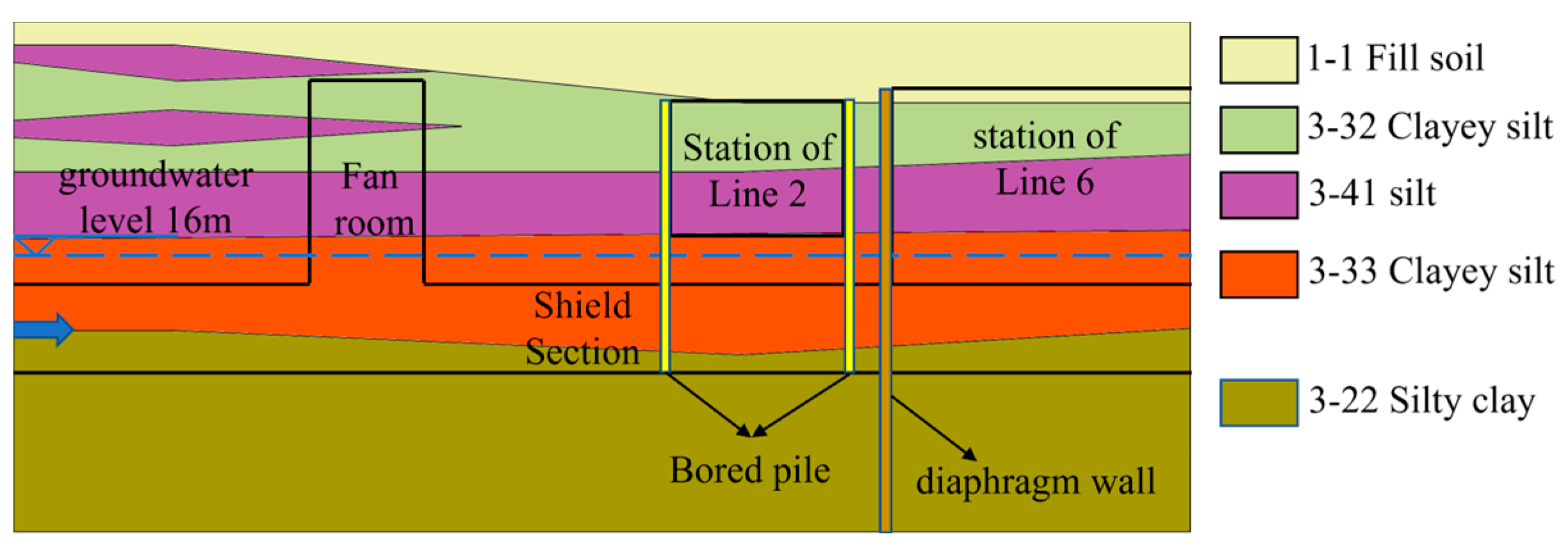
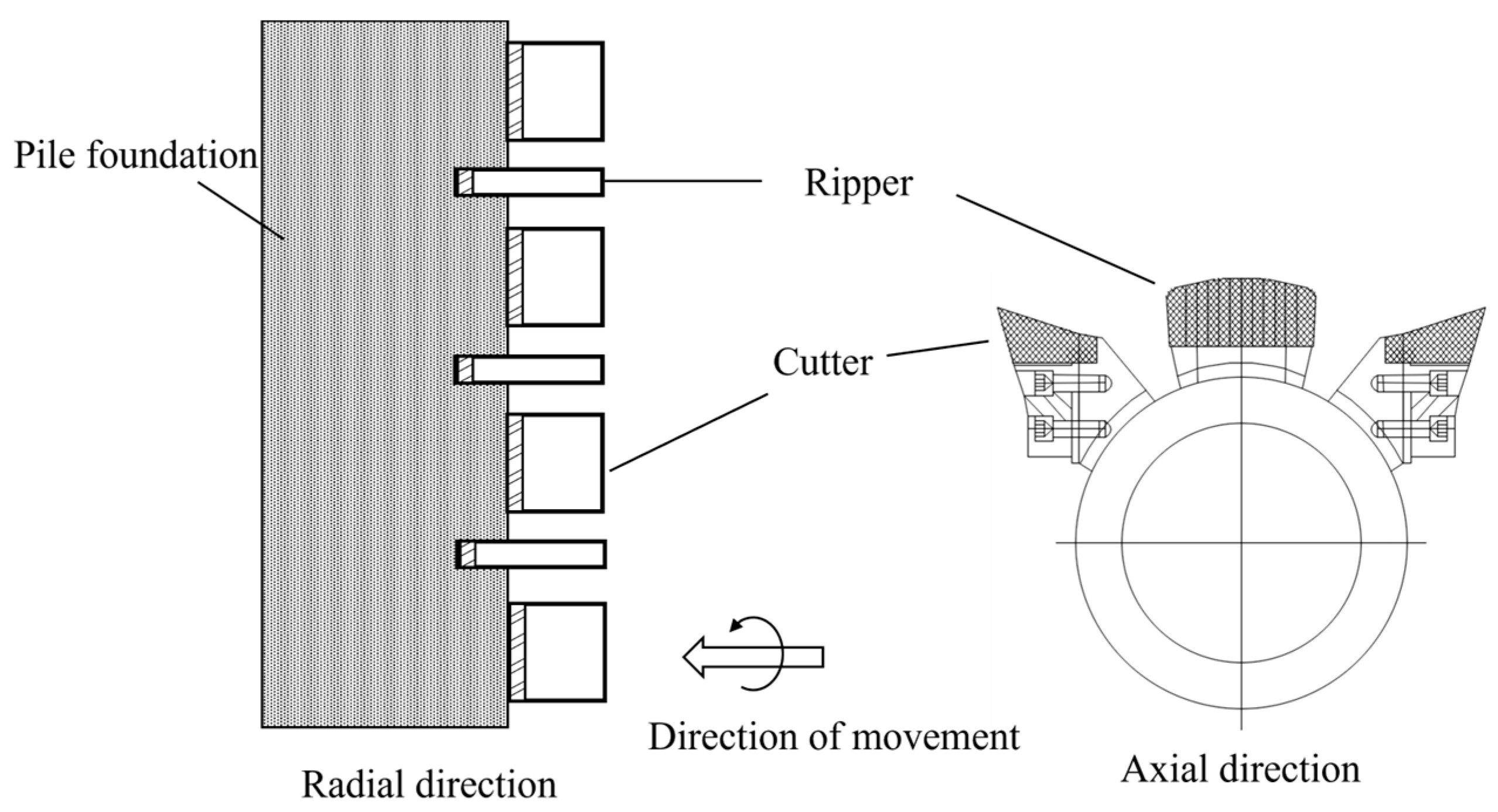
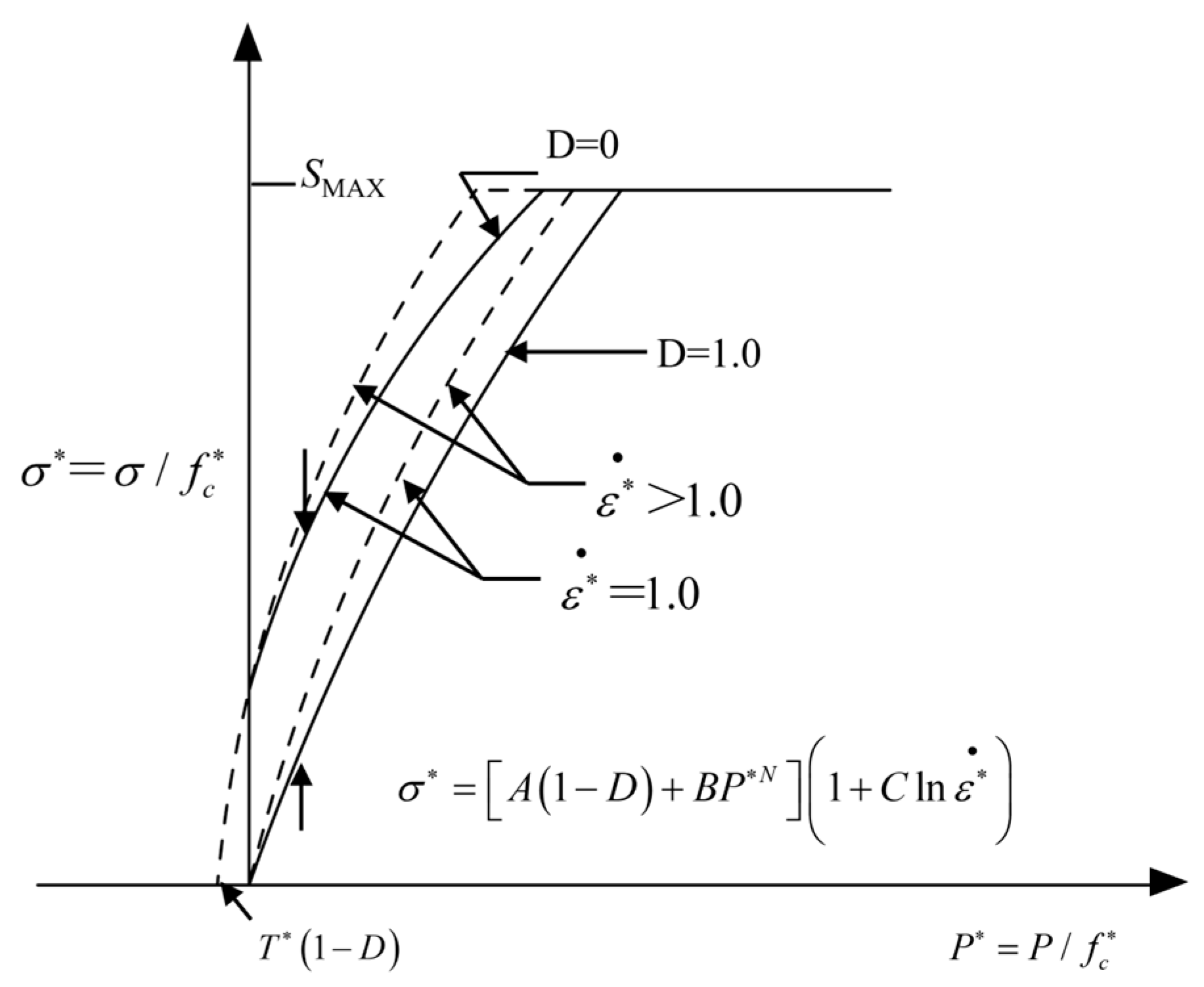
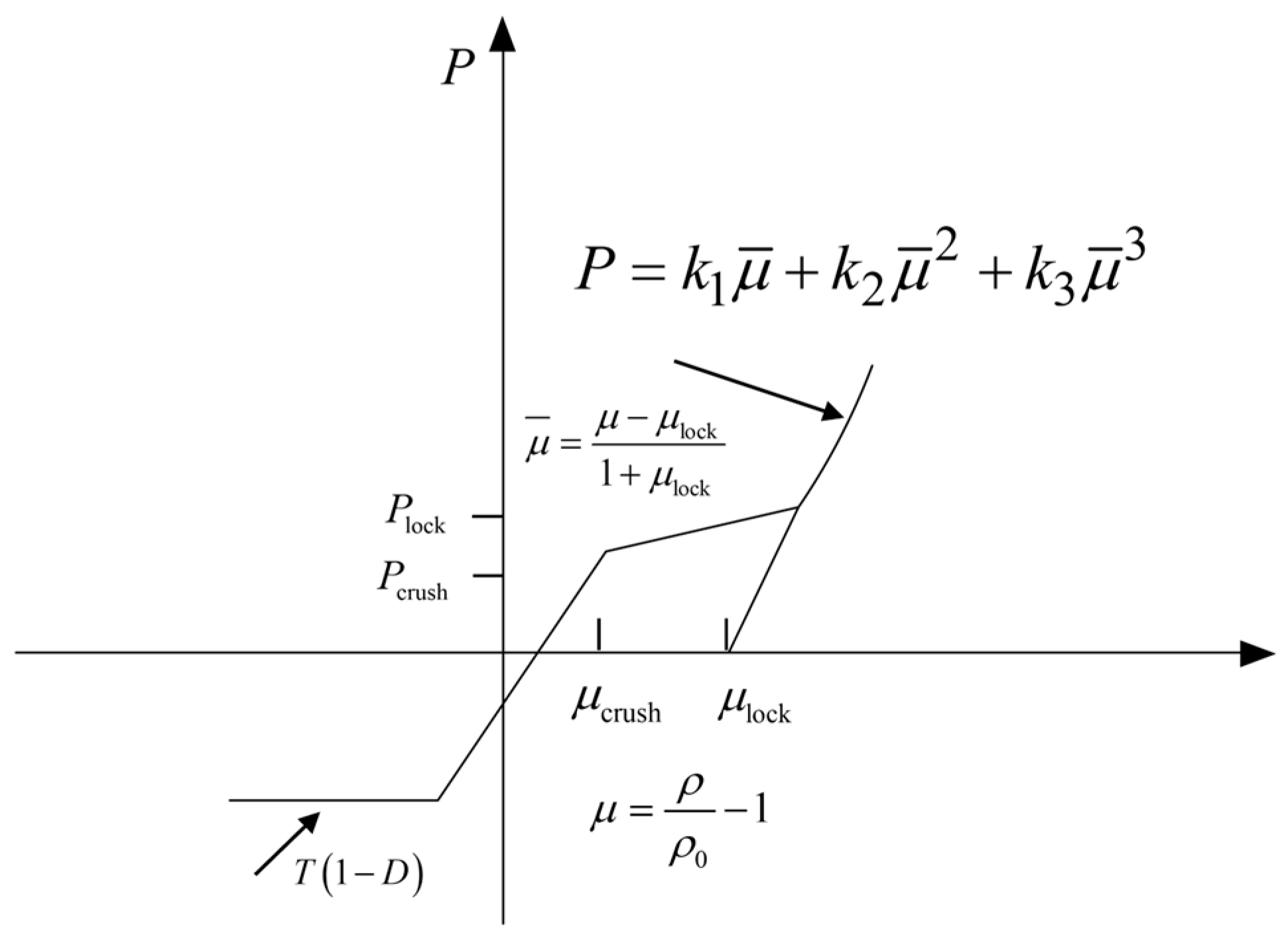

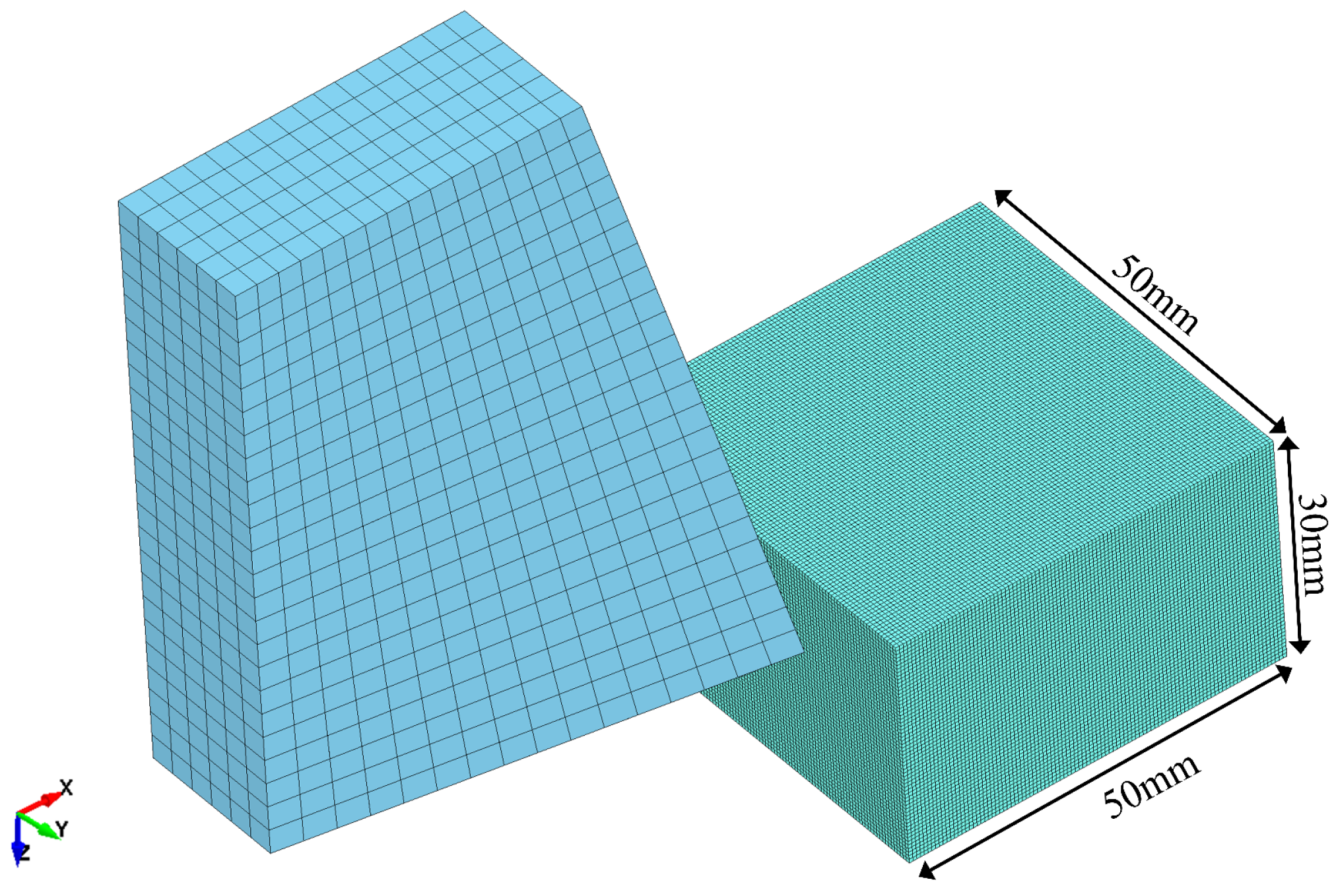
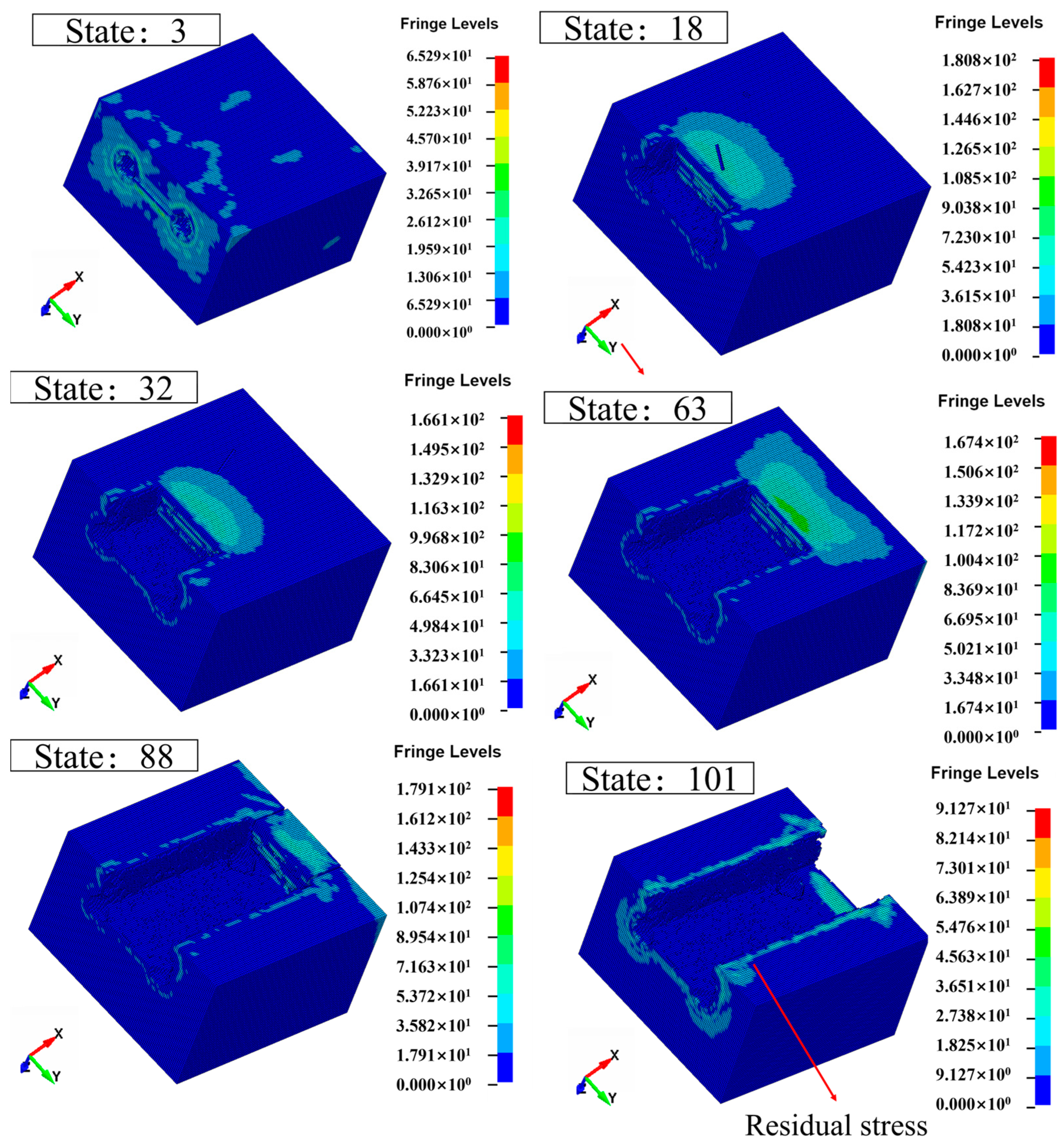

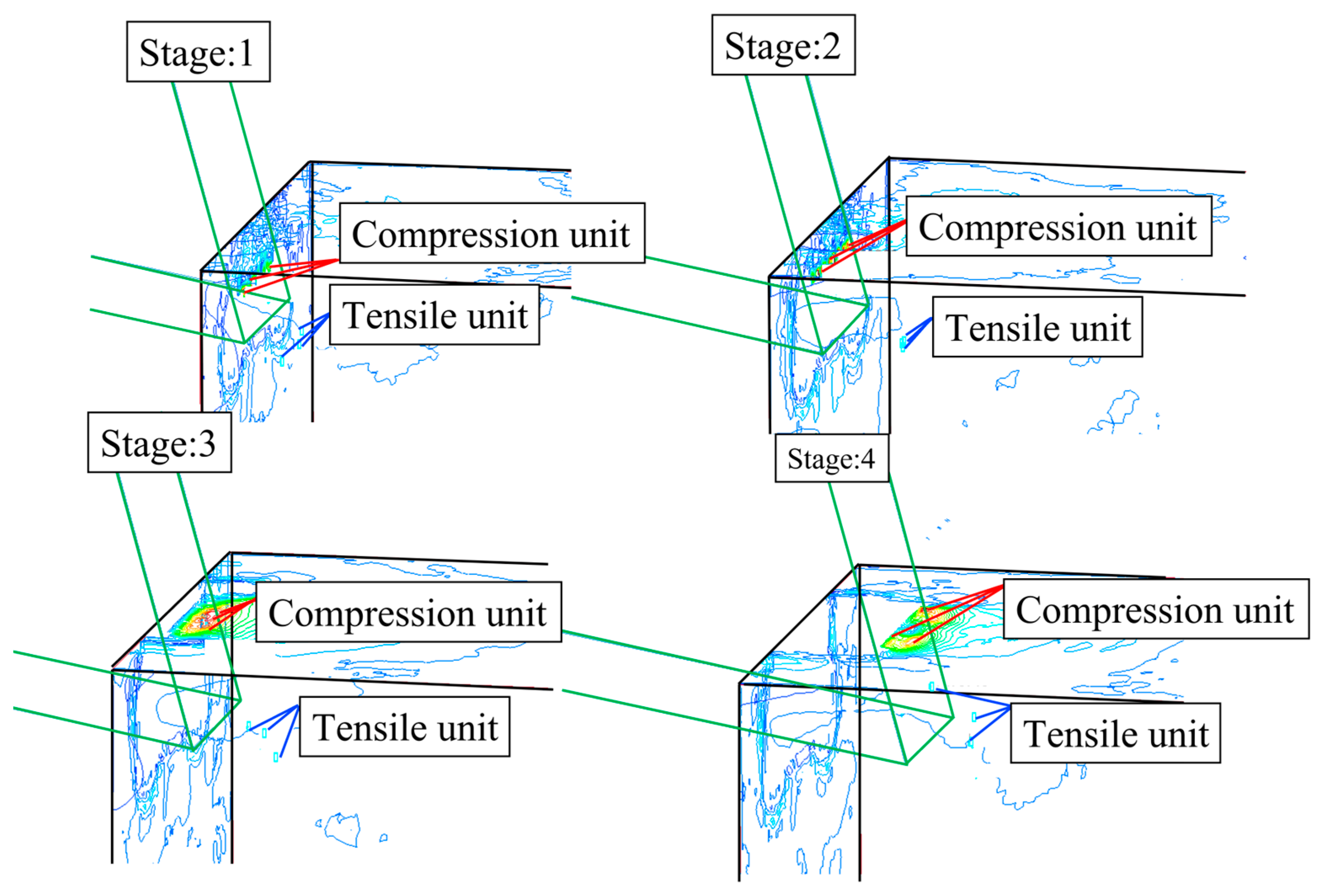
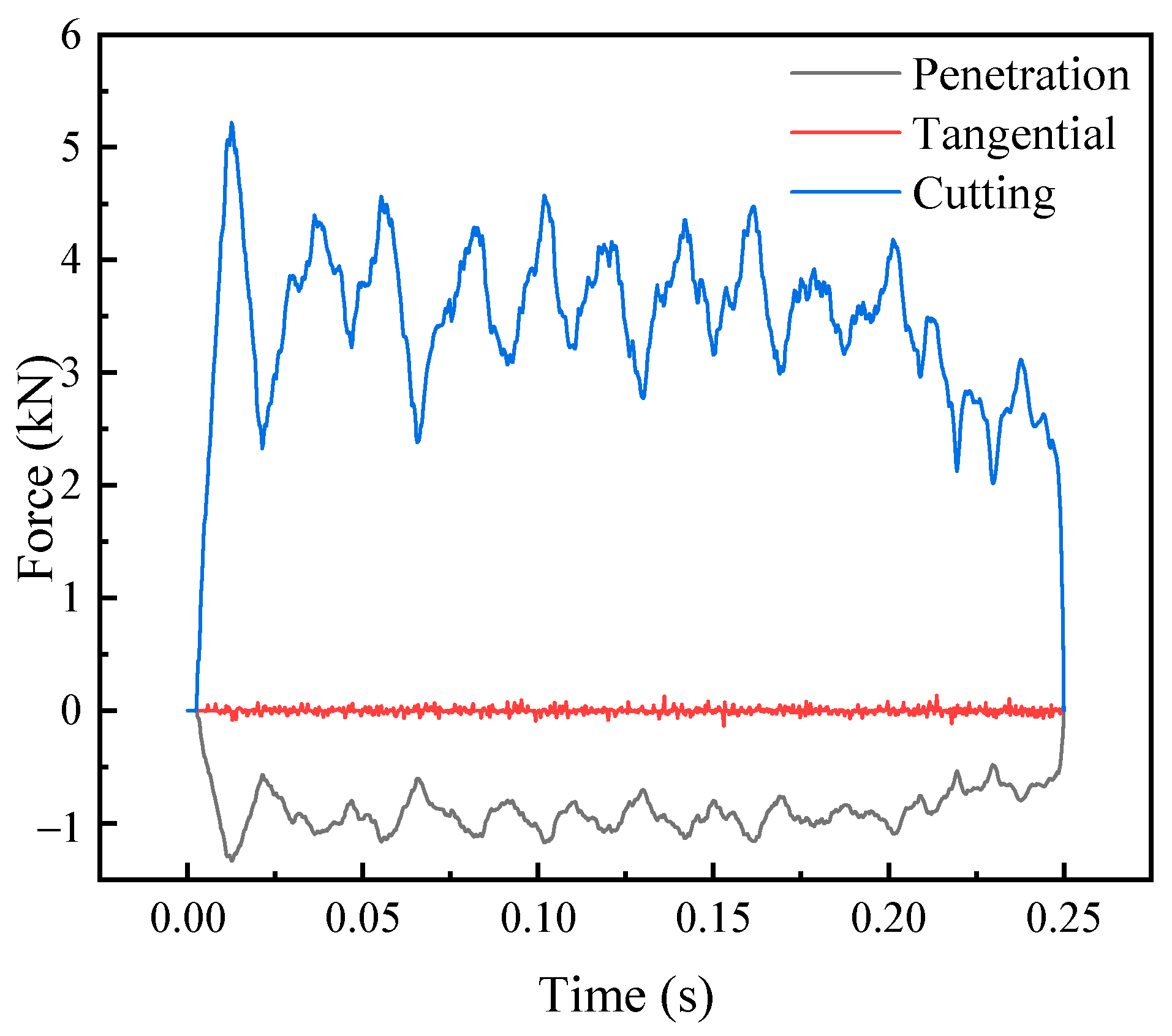
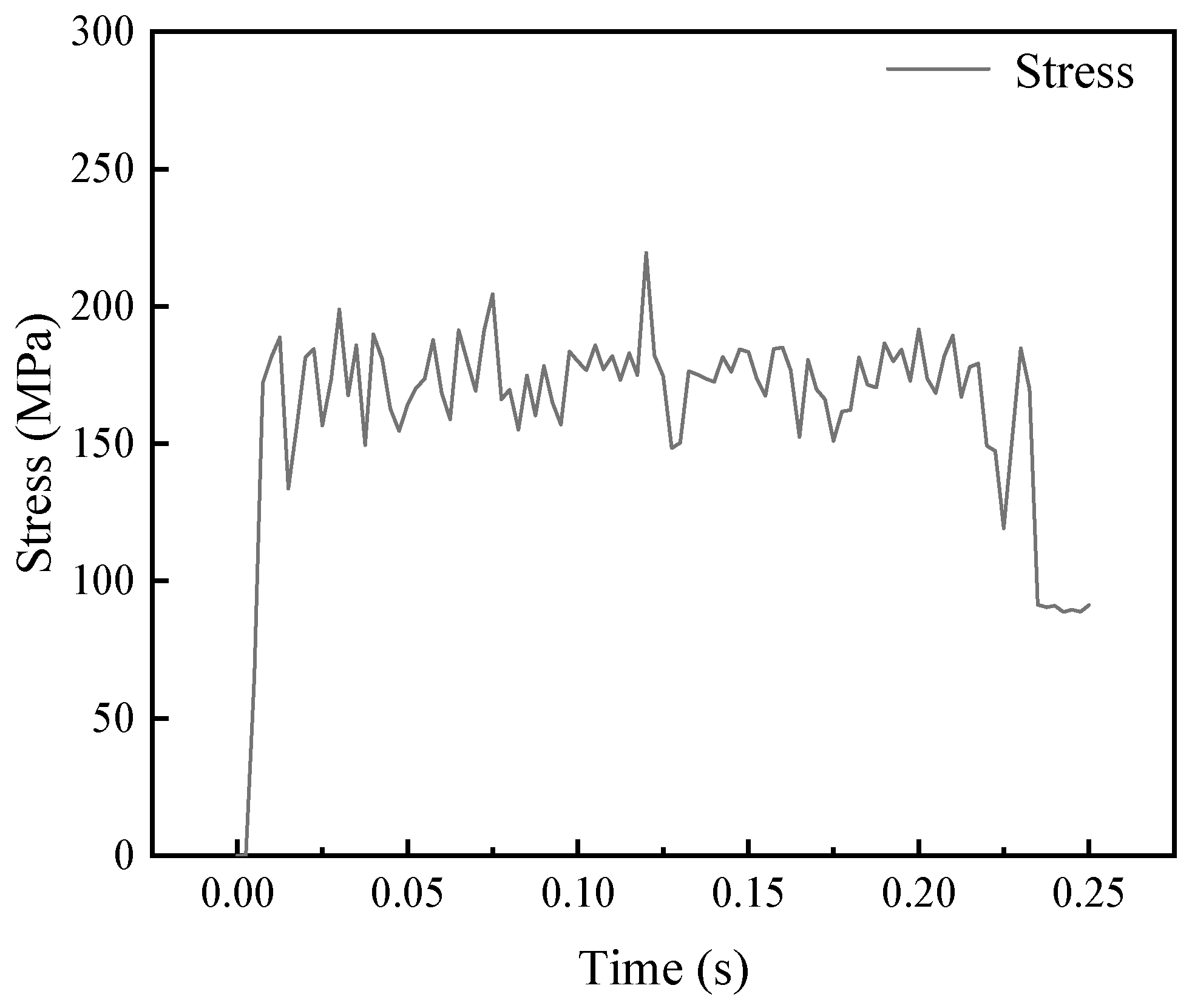
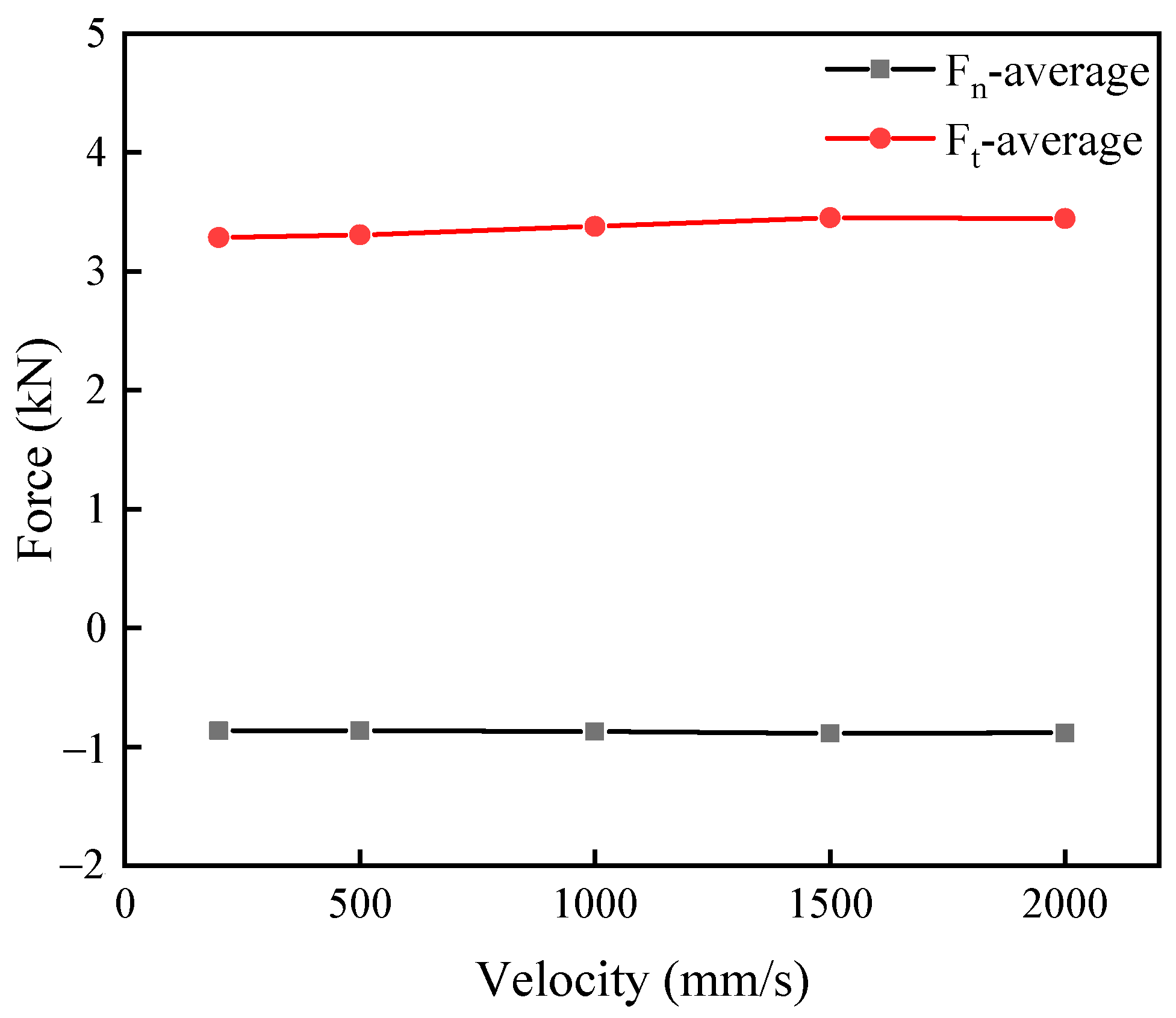

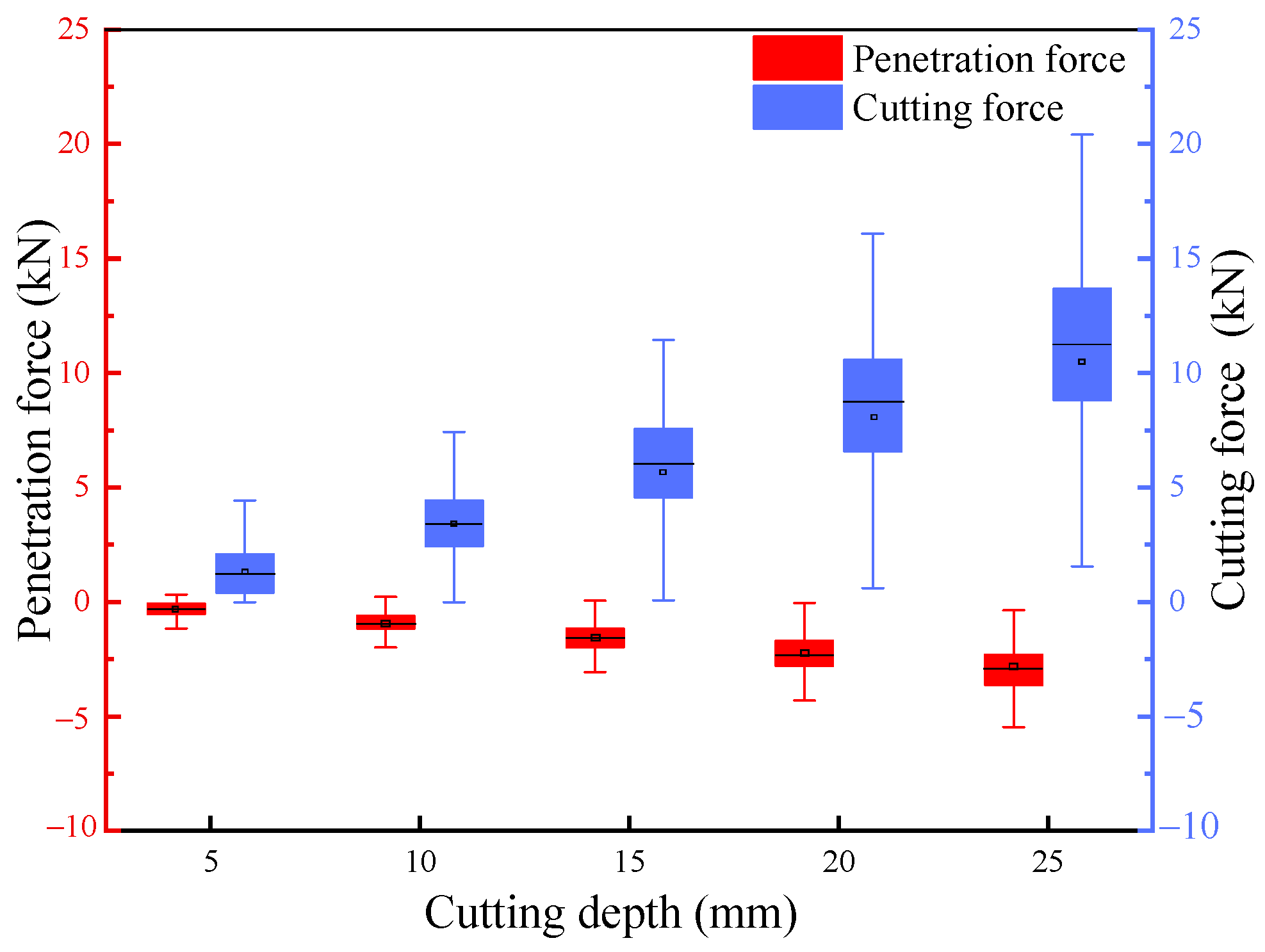
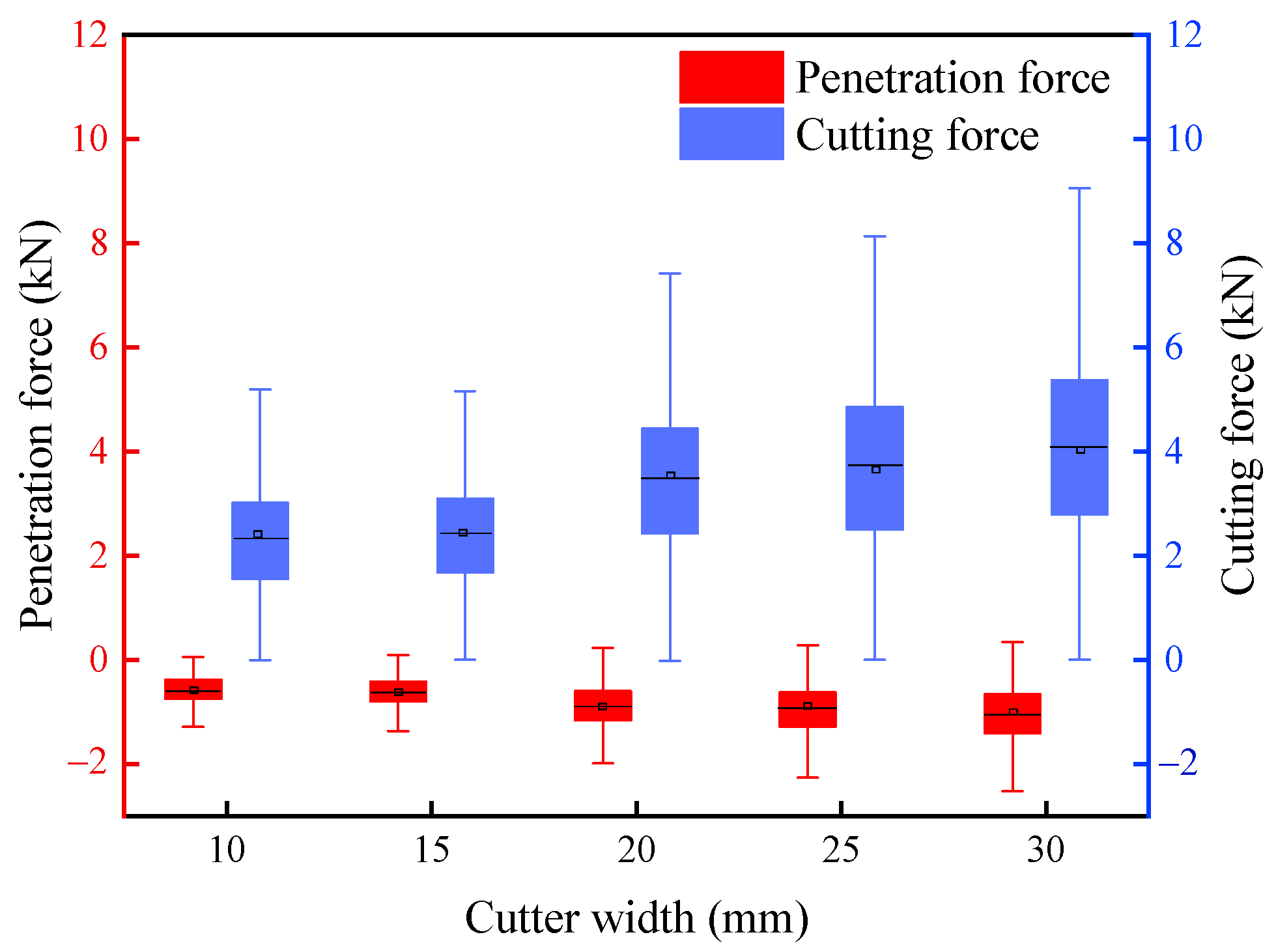
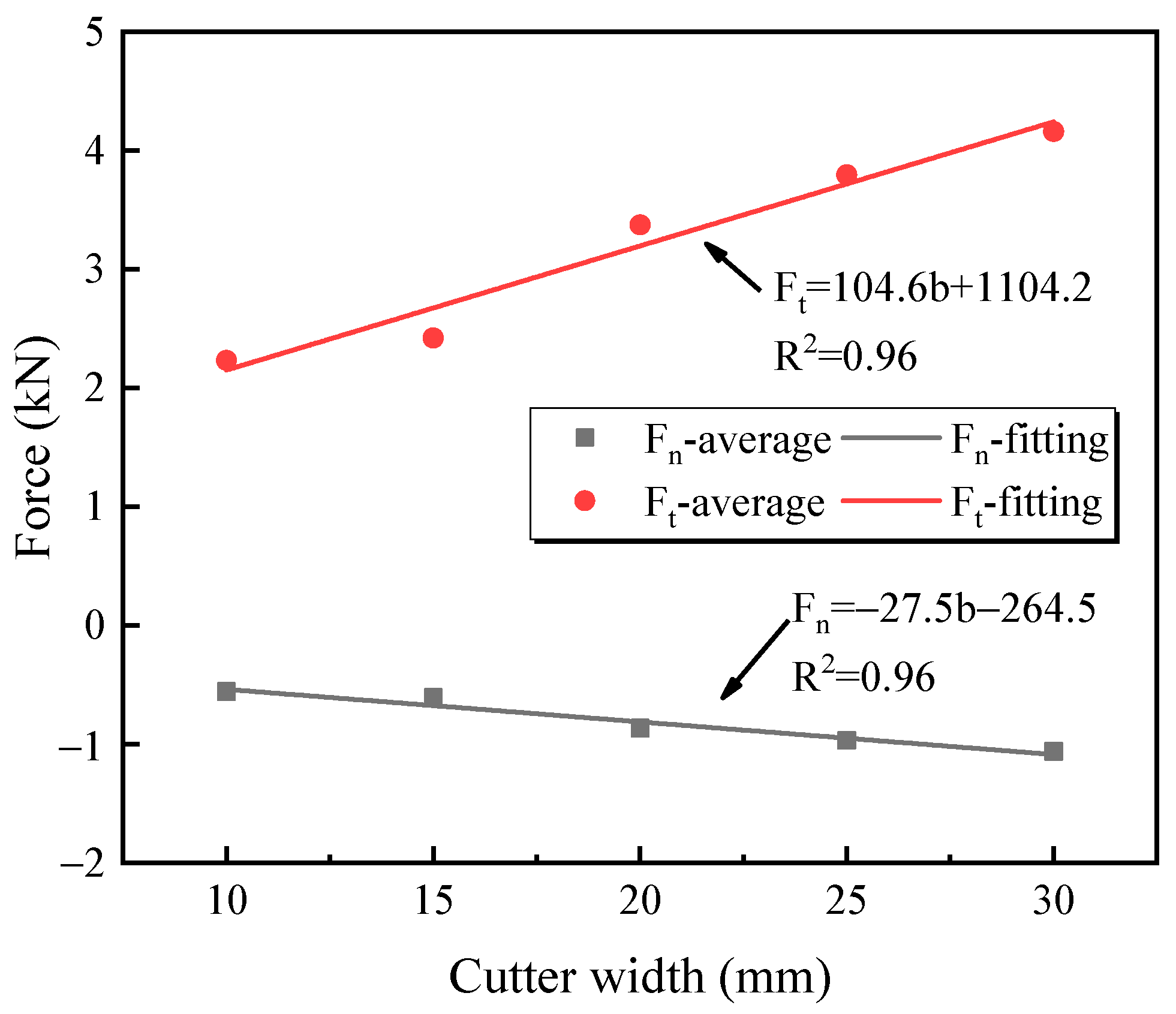
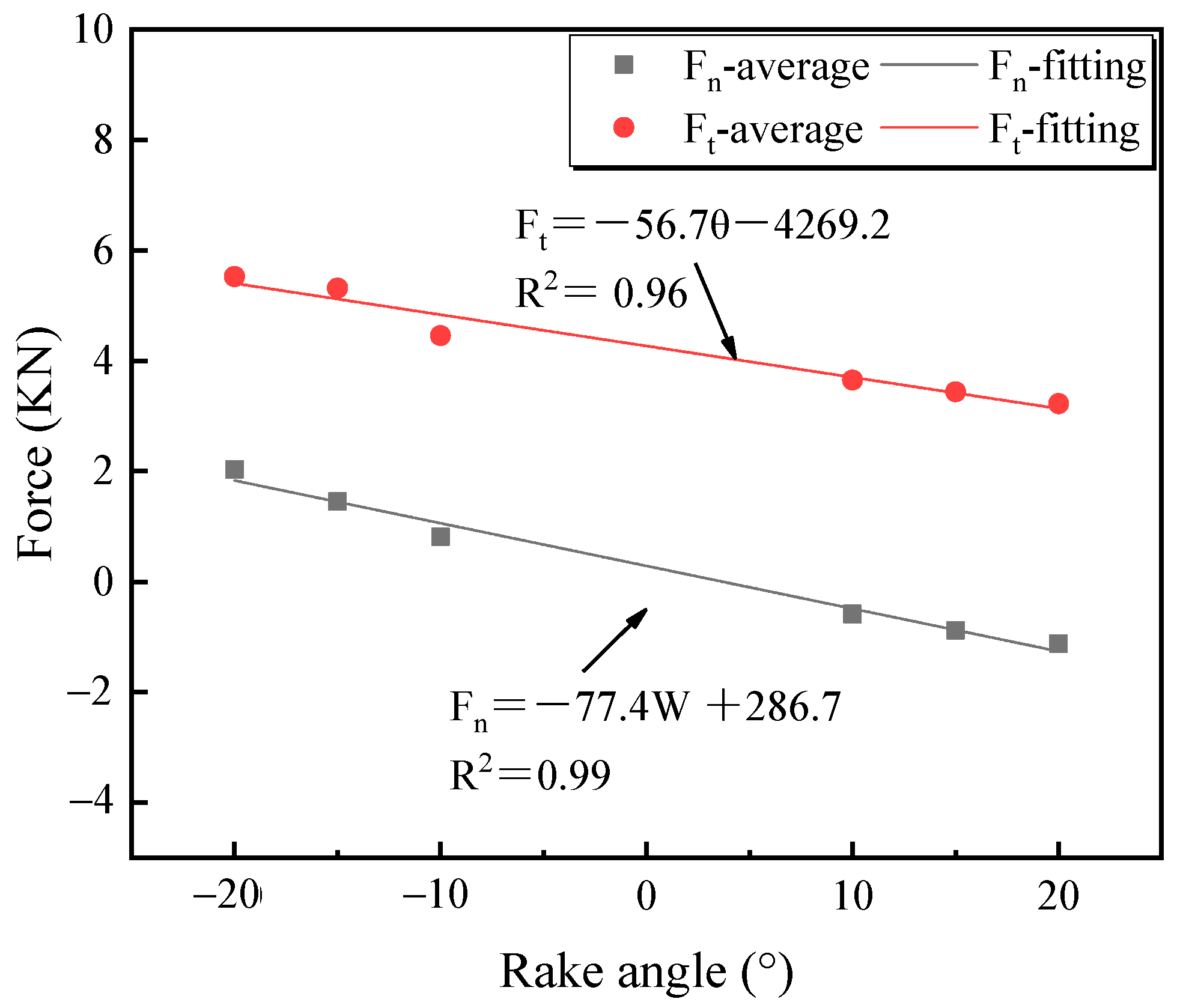

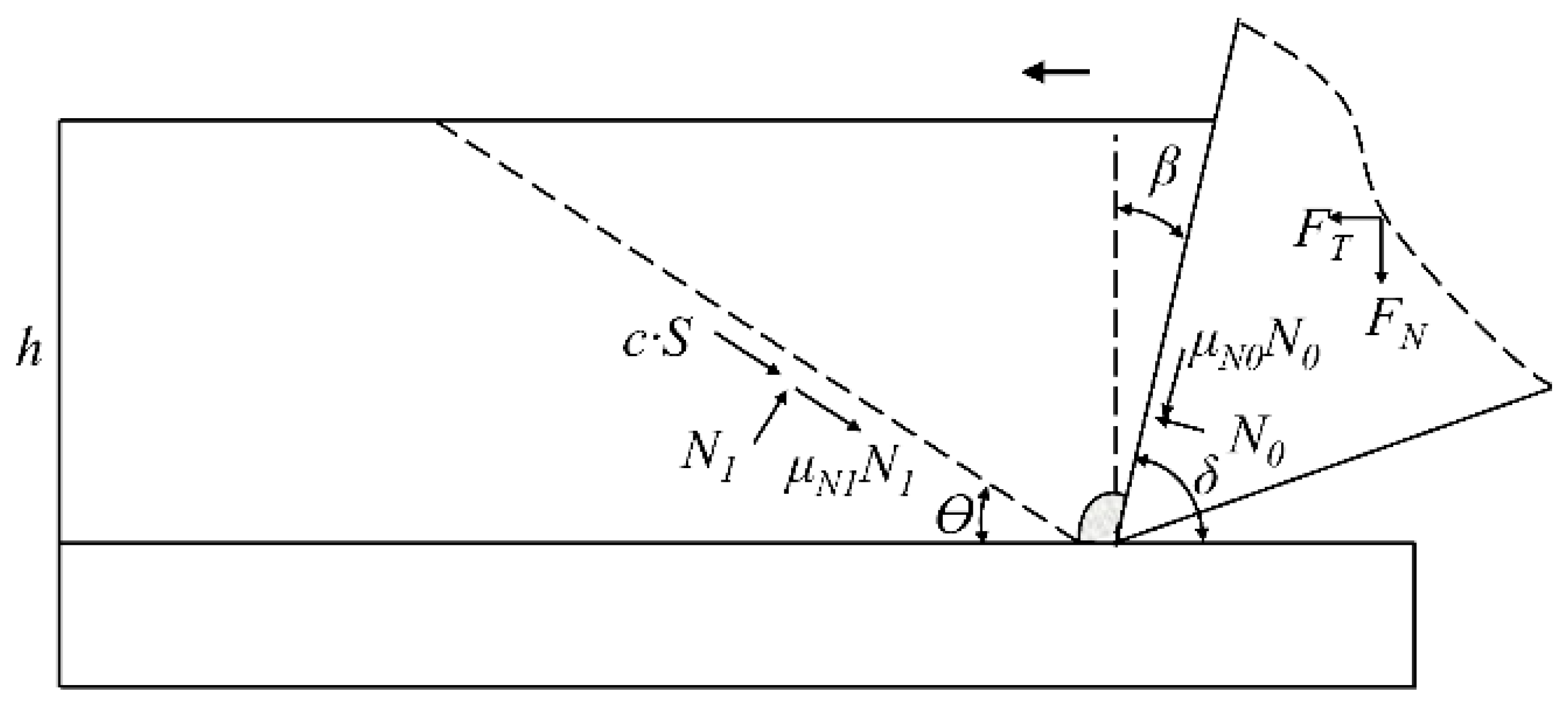
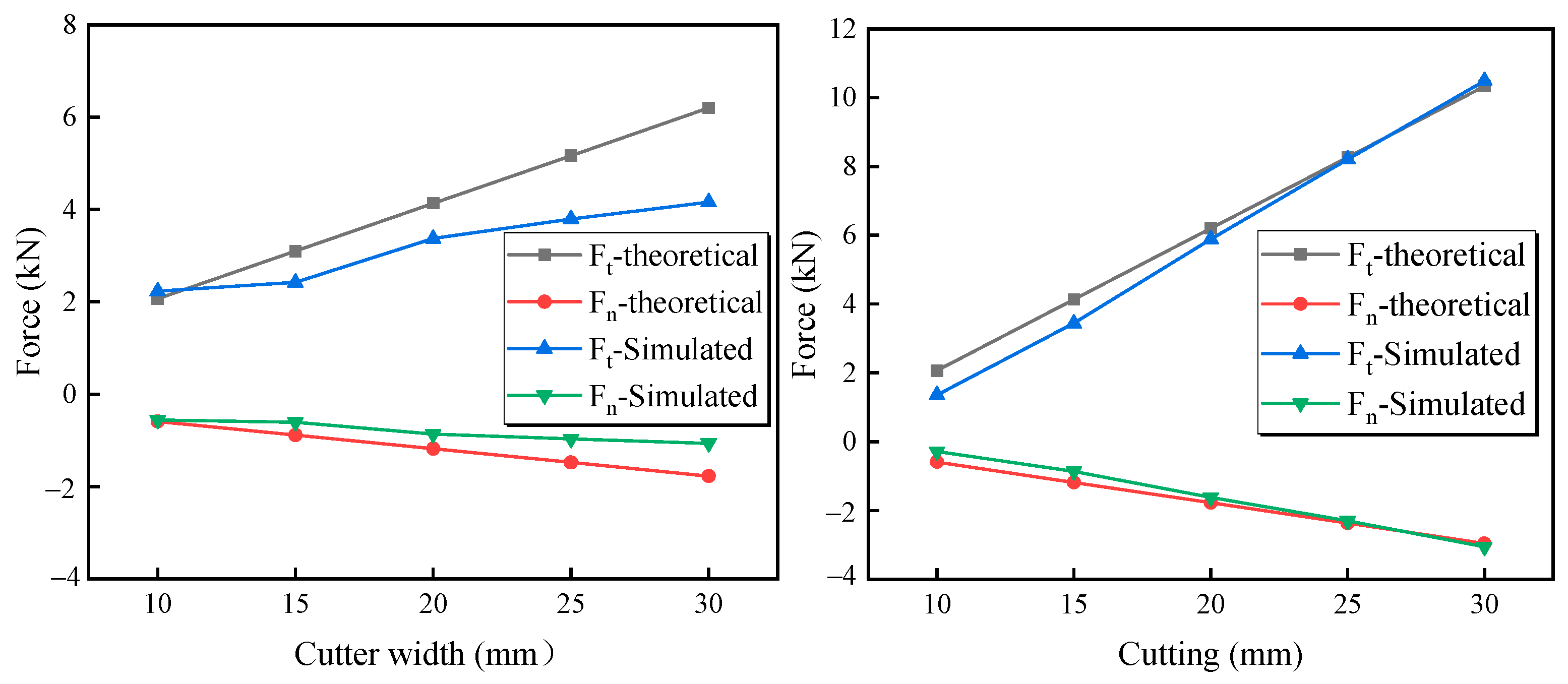
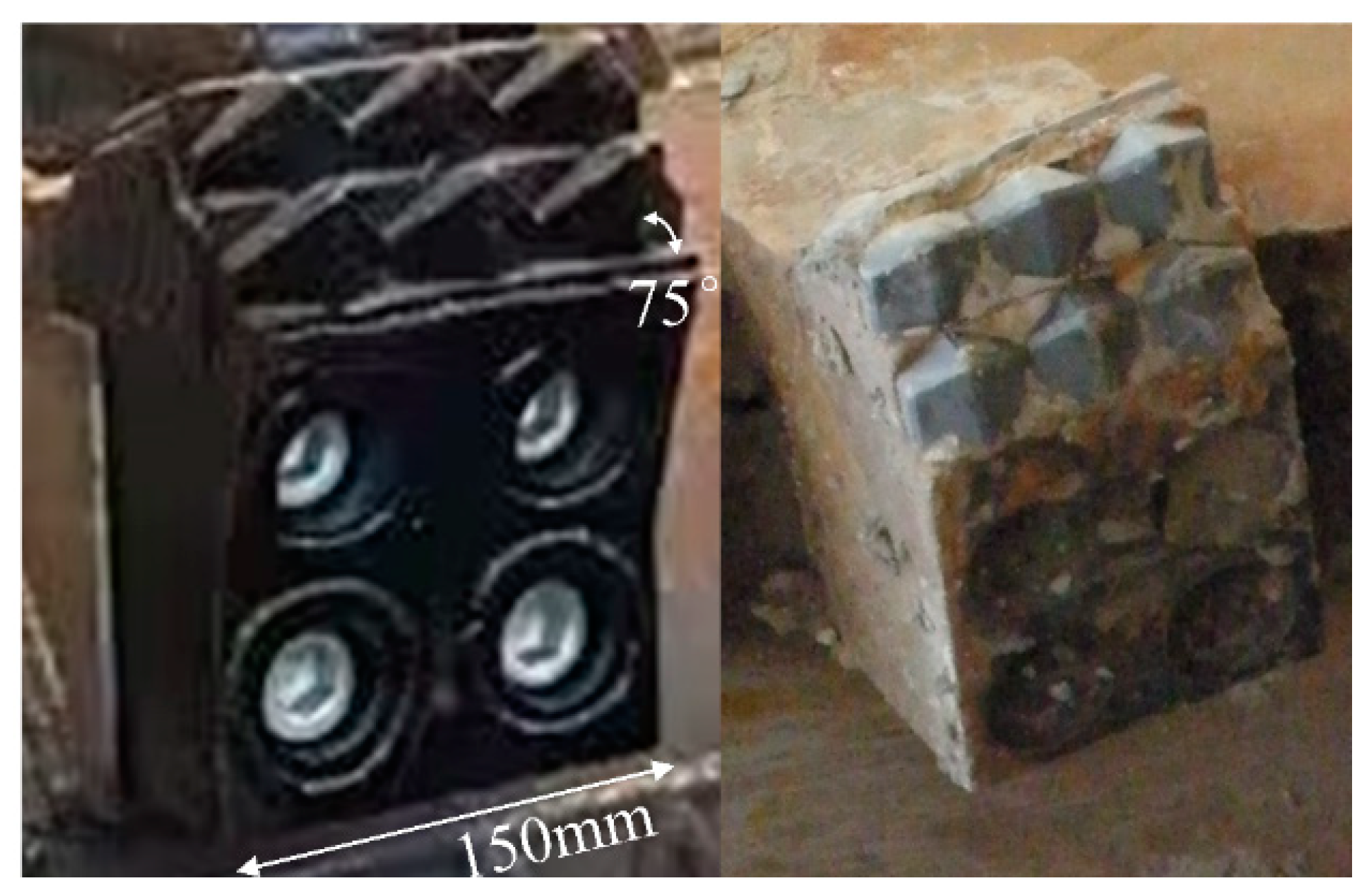
| Soil | Unit Weight (KN/m3) | Compression Modulus (MPa) | Angle of Internal Friction (°s) | Cohesive Forces (KPa) |
|---|---|---|---|---|
| 1-1 Fill soil | 17.9 | 4.9 | 20.0 | 20.0 |
| 3-32 Clayey Silt | 18.8 | 9.1 | 20 | 22.1 |
| 3-41 Silt | 19.3 | 8.6 | 21.1 | 19.8 |
| 3-33 Clayey Silt | 20.3 | 10.1 | 17.3 | 37.1 |
| 3-22 Silty clay | 20.3 | 9.7 | 19.7 | 41.6 |
| ρ/(kg/m3) | G/(GPa) | fc/(GPa) | T/(GPa) | A | B | N | C | SFmax | EPS0 |
|---|---|---|---|---|---|---|---|---|---|
| 2400 | 13 | 0.04 | 0.00392 | 0.79 | 1.6 | 0.61 | 0.007 | 11 | 1 |
| Pc (GPa) | μc | P1/(GPa) | μ1 | K1 | K2 | K3 | D1 | D2 | εfmin |
| 0.0133 | 0.001 | 0.95 | 0.1 | 85 | 171 | 208 | 0.04 | 1 | 0.01 |
| Influencing Factors | Variable Quantity | Quantification |
|---|---|---|
| Cutting speed/(mm/s) | 200, 500, 1000, 1500, 2000 | 200 |
| Cutting depth/(mm) | 5, 10, 15, 20, 25 | 10 |
| Cutter width/(mm) | 10, 15, 20, 25, 30 | 20 |
| Angle of cutting edge/(°) | −20, −15, −10, 10, 15, 20 | 15 |
| Test Number | X1 | X2 | X3 | Y |
|---|---|---|---|---|
| Rake Angle (°) | Cutter Width (mm) | Cutting Depth (mm) | Cutting Force (kN) | |
| 1 | 10 | 10 | 5 | 0.91 |
| 2 | 10 | 15 | 10 | 2.16 |
| 3 | 10 | 20 | 15 | 5.71 |
| 4 | 15 | 10 | 10 | 2.32 |
| 5 | 15 | 15 | 15 | 4.22 |
| 6 | 15 | 20 | 5 | 1.58 |
| 7 | 20 | 10 | 15 | 4.33 |
| 8 | 20 | 15 | 5 | 0.77 |
| 9 | 20 | 20 | 10 | 3.92 |
| k1 | 8.79 | 7.56 | 3.26 | |
| k2 | 8.11 | 7.15 | 8.39 | |
| k3 | 9.01 | 11.20 | 14.26 | |
| k1 | 2.93 | 2.52 | 1.09 | |
| k2 | 2.70 | 2.38 | 2.80 | |
| k3 | 3.00 | 3.73 | 4.75 | |
| R | 0.30 | 1.35 | 3.67 | |
| Primary and secondary | X3 > X2 > X1 | |||
| Source | Type III Sum of Squares | Degree of Freedom | Mean Square | F | Statistical Significance |
|---|---|---|---|---|---|
| Modified model | 23.671 | 6 | 3.945 | 45.644 | 0.022 |
| Intercept | 74.650 | 1 | 74.650 | 863.667 | 0.001 |
| Rake angle | 0.145 | 2 | 0.072 | 0.838 | 0.544 |
| Cutter width | 3.330 | 2 | 1.665 | 19.266 | 0.049 |
| Cutting depth | 20.195 | 2 | 10.098 | 116.827 | 0.008 |
| Error | 0.173 | 2 | 0.086 | ||
| Sum | 98.493 | 9 | |||
| Total after modification | 23.844 | 8 |
Disclaimer/Publisher’s Note: The statements, opinions and data contained in all publications are solely those of the individual author(s) and contributor(s) and not of MDPI and/or the editor(s). MDPI and/or the editor(s) disclaim responsibility for any injury to people or property resulting from any ideas, methods, instructions or products referred to in the content. |
© 2023 by the authors. Licensee MDPI, Basel, Switzerland. This article is an open access article distributed under the terms and conditions of the Creative Commons Attribution (CC BY) license (https://creativecommons.org/licenses/by/4.0/).
Share and Cite
Guan, X.; Liu, Z.; Xu, H.; Liu, Y.; Ling, X.; Ding, H.; Ren, S.; Lu, R.; Yu, K.; Miao, J. Mechanical Properties and Influencing Factors of Shield Cutting Existing Station Supporting Piles. Sustainability 2023, 15, 11699. https://doi.org/10.3390/su151511699
Guan X, Liu Z, Xu H, Liu Y, Ling X, Ding H, Ren S, Lu R, Yu K, Miao J. Mechanical Properties and Influencing Factors of Shield Cutting Existing Station Supporting Piles. Sustainability. 2023; 15(15):11699. https://doi.org/10.3390/su151511699
Chicago/Turabian StyleGuan, Xiaoming, Zeliang Liu, Huawei Xu, Yanchun Liu, Xianzhang Ling, Hao Ding, Sihao Ren, Ruiquan Lu, Ke Yu, and Jijun Miao. 2023. "Mechanical Properties and Influencing Factors of Shield Cutting Existing Station Supporting Piles" Sustainability 15, no. 15: 11699. https://doi.org/10.3390/su151511699
APA StyleGuan, X., Liu, Z., Xu, H., Liu, Y., Ling, X., Ding, H., Ren, S., Lu, R., Yu, K., & Miao, J. (2023). Mechanical Properties and Influencing Factors of Shield Cutting Existing Station Supporting Piles. Sustainability, 15(15), 11699. https://doi.org/10.3390/su151511699









